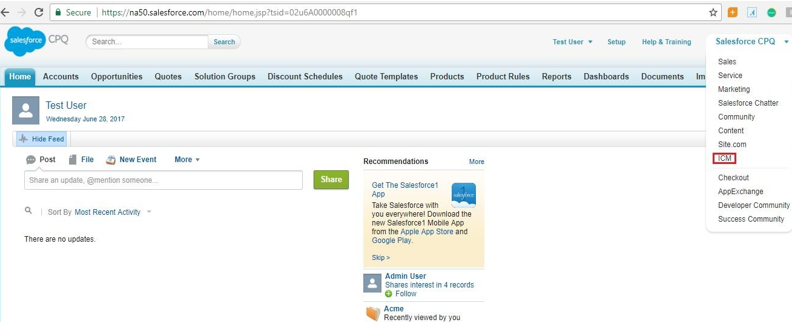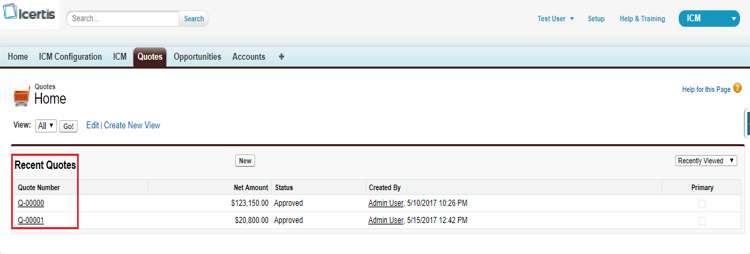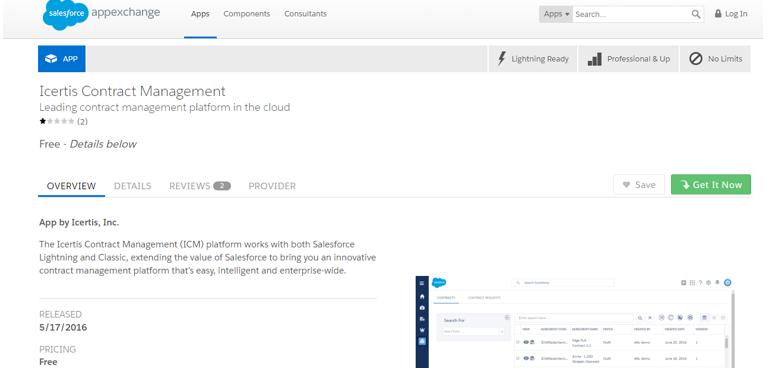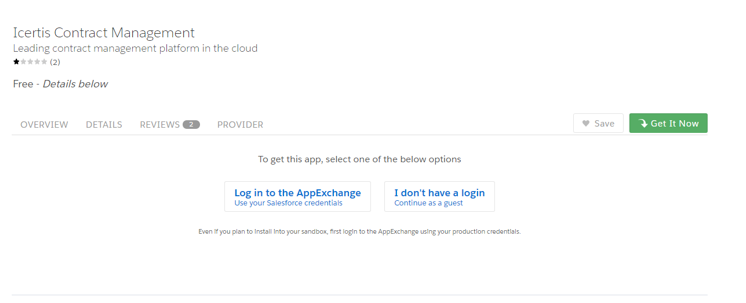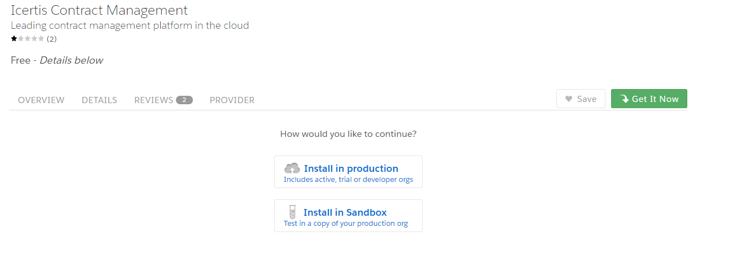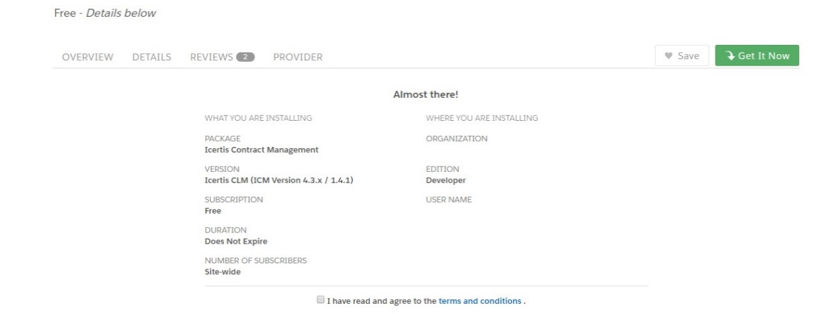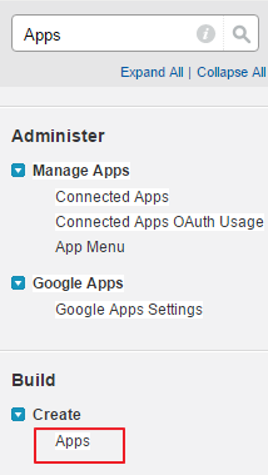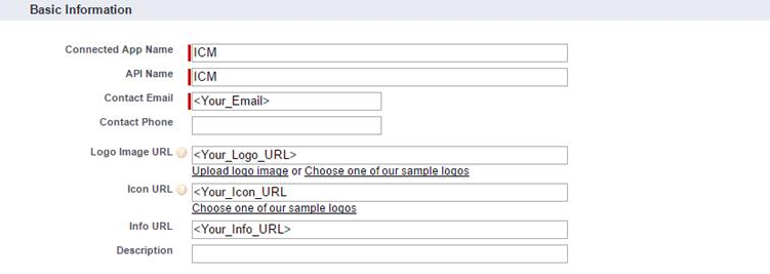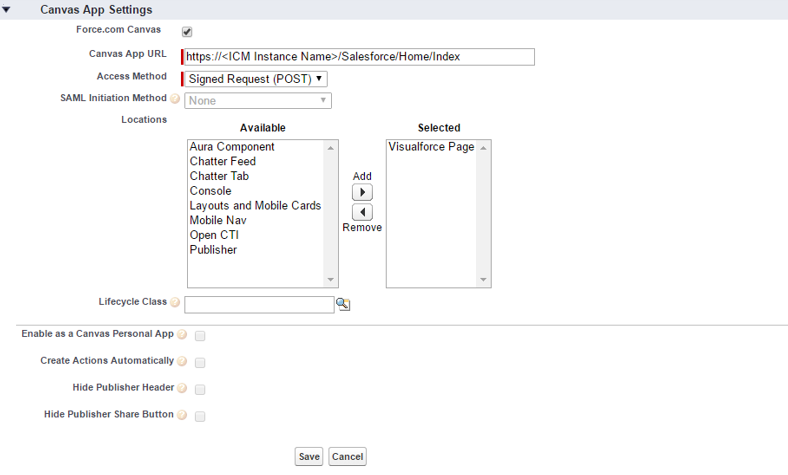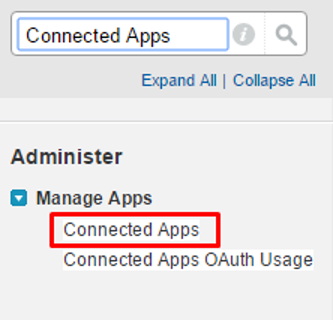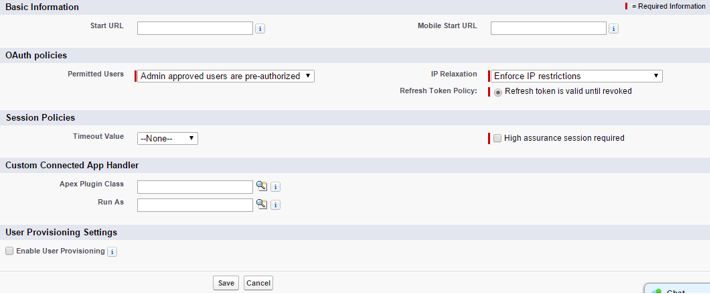| Line 38: | Line 38: | ||
*Automatically transfer and synchronize data between Salesforce objects and ICM. | *Automatically transfer and synchronize data between Salesforce objects and ICM. | ||
*Map Salesforce objects (standard and custom) with ICM entities. | *Map Salesforce objects (standard and custom) with ICM entities. | ||
| − | <div class="image-green-border">[[File:Overview of ICM Salesforce.PNG]]</div> | + | <div class="image-green-border">[[File:Overview of ICM Salesforce.PNG|RTENOTITLE]]</div> |
ICM and Salesforce integration is required to port data from ICM to Salesforce. This integration avoids the need for re-entering the data manually in Salesforce which you have already created in ICM. | ICM and Salesforce integration is required to port data from ICM to Salesforce. This integration avoids the need for re-entering the data manually in Salesforce which you have already created in ICM. | ||
| Line 49: | Line 49: | ||
*''Account'' is a label for business. It is a company or a business entity, you might already be working with, or one that you hope to work with. In simple words, an Account is the actual business or company. | *''Account'' is a label for business. It is a company or a business entity, you might already be working with, or one that you hope to work with. In simple words, an Account is the actual business or company. | ||
| − | <div class="image-green-border">[[File:Overview of ICM Salesforce2.PNG]]</div> | + | <div class="image-green-border">[[File:Overview of ICM Salesforce2.PNG|RTENOTITLE]]</div> |
*''Opportunity'' is a pending deal with a monetary value associated with it. It helps to track the pending deals and sales. | *''Opportunity'' is a pending deal with a monetary value associated with it. It helps to track the pending deals and sales. | ||
| − | <div class="image-green-border">[[File:Overview of ICM Salesforce3.PNG]]</div> | + | <div class="image-green-border">[[File:Overview of ICM Salesforce3.PNG|RTENOTITLE]]</div> |
*''Quote'' is the data showing the proposed prices for the products or services. Quotes can be created by using the data that is saved in the Opportunities and shared with the prospective customers. Every opportunity can have multiple associated quotes linked to it. | *''Quote'' is the data showing the proposed prices for the products or services. Quotes can be created by using the data that is saved in the Opportunities and shared with the prospective customers. Every opportunity can have multiple associated quotes linked to it. | ||
| − | [[File:Overview of ICM Salesforce4.PNG]] | + | [[File:Overview of ICM Salesforce4.PNG|RTENOTITLE]] |
After integrating ICM with Salesforce, you can do the following contract management tasks in Salesforce: | After integrating ICM with Salesforce, you can do the following contract management tasks in Salesforce: | ||
| Line 83: | Line 83: | ||
*Performance | *Performance | ||
| − | For more information about the different editions of Salesforce, refer to: <br/> [https://help.salesforce.com/articleView?id=overview_edition.htm&type= | + | For more information about the different editions of Salesforce, refer to: <br/> [[https://help.salesforce.com/articleView?id=overview_edition.htm&type=0 https://help.salesforce.com/articleView?id=overview_edition.htm&type=0] |
| − | https://help.salesforce.com/articleView?id=overview_edition.htm&type=0 ] | + | [https://help.salesforce.com/articleView?id=overview_edition.htm&type=0 https://help.salesforce.com/articleView?id=overview_edition.htm&type=0 ]] |
=== Installing ICM in Salesforce === | === Installing ICM in Salesforce === | ||
| Line 92: | Line 92: | ||
1. Log on to Salesforce.<br/> 2. Open a new browser instance and go to Salesforce AppExchange to download the ICM application. | 1. Log on to Salesforce.<br/> 2. Open a new browser instance and go to Salesforce AppExchange to download the ICM application. | ||
| − | <div class="image-green-border">[[File:Installing ICM in Salesforce.PNG]]</div> <div class="image-green-border"> </div> <div class="image-green-border">3. '''Click''' ''Get It'' Now. This opens a new screen having two options:</div> | + | <div class="image-green-border">[[File:Installing ICM in Salesforce.PNG|RTENOTITLE]]</div> <div class="image-green-border"> </div> <div class="image-green-border">3. '''Click''' ''Get It'' Now. This opens a new screen having two options:</div> |
*Log in to AppExchange: '''Logon''' to AppExchange using your Salesforce credentials to proceed with the installation. | *Log in to AppExchange: '''Logon''' to AppExchange using your Salesforce credentials to proceed with the installation. | ||
*I don’t have a login: '''Install''' ICM in Salesforce as a guest user. | *I don’t have a login: '''Install''' ICM in Salesforce as a guest user. | ||
| − | <div class="image-green-border">[[File:Installing ICM in Salesforce2.PNG]]<br/> <br/> 4. Choose Log into AppExchange. This presents the following options:</div> | + | <div class="image-green-border">[[File:Installing ICM in Salesforce2.PNG|RTENOTITLE]]<br/> <br/> 4. Choose Log into AppExchange. This presents the following options:</div> |
*Install in production | *Install in production | ||
*Install in Sandbox | *Install in Sandbox | ||
| − | [[File:Installing ICM in Salesforce3.PNG]] | + | [[File:Installing ICM in Salesforce3.PNG|RTENOTITLE]] |
| − | <div class="image-green-border">5. '''Choose''' ''Install in production'' and select the Terms and Conditions checkbox.</div> <div class="image-green-border"> </div> <div class="image-green-border">[[File:Installing ICM in Salesforce4.PNG]]<br/> <br/> 6. Choose one of the applicable options:</div> | + | <div class="image-green-border">5. '''Choose''' ''Install in production'' and select the Terms and Conditions checkbox.</div> <div class="image-green-border"> </div> <div class="image-green-border">[[File:Installing ICM in Salesforce4.PNG|RTENOTITLE]]<br/> <br/> 6. Choose one of the applicable options:</div> |
*Install for Admins only: install ICM for Salesforce Administrators who can install ICM in Salesforce. | *Install for Admins only: install ICM for Salesforce Administrators who can install ICM in Salesforce. | ||
*Install for All Users: install ICM for all users of Salesforce. | *Install for All Users: install ICM for all users of Salesforce. | ||
| Line 111: | Line 111: | ||
Follow these steps to create a Canvas App: | Follow these steps to create a Canvas App: | ||
| − | 1. In '''Salesforce''', under ''Setup'', '''search '''for ''Apps'' in the''Quick Find'' box and '''select''' Apps. | + | 1. In '''Salesforce''', under ''Setup'', '''search '''for ''Apps'' in the ''Quick Find'' box and '''select''' Apps. |
| + | <div class="image-green-border">[[File:Creating and Managing the Canvas App.PNG]]</div> <div class="image-green-border"> </div> <div class="image-green-border">2. In the ''Connected Apps related'' list, '''click '''New.</div> <div class="image-green-border"> </div> <div class="image-green-border">[[File:Creating and Managing the Canvas App2.PNG]]</div> <div class="image-green-border"> </div> <div class="image-green-border">3. In the ''Connected App Name'' field, '''type '''the name of the Canvas App.<br/> 4. Accept the default API Name. This is the internal name of the Canvas App and you cannot change the name after saving it.<br/> 5. In the ''Contact Email'' field, '''type''' your valid email address.<br/> 6. In the ''Logo Image URL'' field, '''type''' the ''Logo URL'' that you want to provide.<br/> 7. In the ''Icon URL'' field, '''type''' the ''Icon URL'' that you want to provide.</div> <div class="image-green-border"> </div> <div class="image-green-border">[[File:Creating and Managing the Canvas App3.PNG]]</div> <div class="image-green-border"> </div> <div class="image-green-border">8. In the ''API'' (''Enable OAuth Settings'') section '''select '''the Enable OAuth Settings field.<br/> 9. In the ''Callback'' URL field, '''type''' your ''Callback'' URL. <br/> 10. In the ''Selected OAuth Scopes'' field, '''select''' Full Access.<br/> 11. In the ''Canvas App Settings'' section, '''select '''''Force.com Canvas''.<br/> 12. In the ''Canvas App URL'' field, '''type''' the application URL that you want to sync with Salesforce. This is the application URL, which is integrated with Salesforce.<br/> 13. In the ''Access Method'' field, '''select''' ''Signed Request'' (Post)<br/> 14. In the ''Locations'' field, '''select''' ''Visualforce'' Page.</div> <div class="image-green-border"> </div> <div class="image-green-border">[[File:Creating and Managing the Canvas App4.PNG]]</div> <div class="image-green-border"> </div> <div class="image-green-border">15. '''Click''' ''Save''.</div> <div class="image-green-border"> </div> | ||
| + | == Managing the Canvas App == | ||
| − | | + | 1. In ''Salesforce'', under ''Setup'', '''search''' for ''Connected Apps'' in the ''Quick Find'' box and then '''select''' the option for managing ''Connected Apps''. |
| + | <div class="image-green-border">[[File:Managing the Canvas App.PNG]]</div> <div class="image-green-border"> </div> <div class="image-green-border">2. '''Click '''the ''ICM App'', and then '''click''' Edit.</div> <div class="image-green-border"> </div> <div class="image-green-border">[[File:Managing the Canvas App2.PNG]]</div> <div class="image-green-border"> </div> <div class="image-green-border">3. In the ''Permitted Users'' field, '''select''' ''Admin approved users are pre-authorized'' so that other ICM users cannot view the Canvas App until they are provided permissions. '''Click '''''OK'' in the<br/> pop-up message that appears. </div> <div class="image-green-border"> <div class="note-box">'''Note''': If you select the All Users may self-authorize option in the Permitted Users field, other ICM users can see the Canvas App, but they would need to approve or deny access to it. </div> | ||
| + | [[File:Managing the Canvas App3.PNG]] | ||
| − | | + | 4. '''Click''' ''Save''. |
| + | </div> <div class="image-green-border">Now, define who can access your Canvas App by using profiles and permission sets. <br/> To understand the following example, consider that you want to give access to the System Administrator profile. </div> <div class="image-green-border"><br/> 1. In the ''Profiles ''related list, '''click''' ''Manage Profiles''. <br/> 2. '''Select '''the ''System Administrator'' profile and '''click''' Save.</div> <div class="image-green-border"> </div> | ||
| + | == Configuring ICM EndPoint == | ||
| − | '''Related Topics:''' [[Agreement_Management|Agreement Management]] | [[Configuration|Configuration]] | [[Integrations|Integrations]] | [[Icertis_Adapter_for_Coupa_Integration|Icertis Adapter for Coupa Integration]] | [[Using_Adobe_Sign|Using Adobe Sign]] | [[Using_DocuSign|Using DocuSign]] | + | You can perform ICM EndPoint Configuration only after you have installed Salesforce ICM from AppExchange. |
| + | <div class="image-green-border">[[File:Configuring ICM EndPoint.PNG]]<br/> </div> <div class="image-green-border">Follow these steps to configure ICM EndPoint:</div> <div class="image-green-border"> </div> <div class="image-green-border">1. '''Click''' ''ICM Configuration'' in the top navigation bar by logging on to the ICM App in Salesforce on ICM App Home page. ''ICM EndPoint Configuration'' page appears.<br/> 2. Provide relevant information in the respective fields:</div> <div class="image-green-border"> </div> <div class="image-green-border"> | ||
| + | {| align="left" border="1" cellpadding="1" cellspacing="1" style="width: 500px;" | ||
| + | |- | ||
| + | | style="width: 183px;" | ''ICM URL'' | ||
| + | | style="width: 294px;" | This field is auto-populated on the ICM Endpoint Configuration page when you create a canvas application through Salesforce ICM. Note that depending on the ICM API URL, you will have to change this URL. Typically, API URL follows below convention,<br/> [https://sfdcdev-api.icertis.com https://sfdcdev-api.icertis.com] | ||
| + | |- | ||
| + | | style="width: 183px;" | ''Canvas App Name Resource URI'' | ||
| + | | style="width: 294px;" | This field is auto-populated on the ICM Endpoint Configuration page when you create the canvas application through Salesforce ICM. You can also add or edit the Canvas App Name manually from the ''ICM Endpoint Configuration'' page | ||
| + | |- | ||
| + | | style="width: 183px;" | ''Resource URI '' | ||
| + | | style="width: 294px;" | This field is auto-populated when you create the canvas application through Salesforce. You must create a ''Saved Search'' in ICM for the Resource URI value to get displayed in Salesforce | ||
| + | |- | ||
| + | | style="width: 183px;" | Enable Reverse Integration | ||
| + | | style="width: 294px;" | '''Select '''this check box to enable reverse integration. This causes the data created in ICM to be displayed in the Salesforce entities (from where the contract creation process was initiated) | ||
| + | |- | ||
| + | | style="width: 183px;" | Enable Quick Contract | ||
| + | | style="width: 294px;" | '''Select '''this checkbox to enable creating the Contract for all Salesforce entities with a single click from Salesforce. | ||
| + | |- | ||
| + | | style="width: 183px;" | ''Enable Iframe'' | ||
| + | | style="width: 294px;" | If the Iframe is disabled from the IDP, then '''select '''this checkbox to enable the Iframe in Salesforce to open the ICM page in Salesforce in a new tab for creating new Agreements and Requests. | ||
| + | |- | ||
| + | | style="width: 183px;" | ''Entity Name'' | ||
| + | | style="width: 294px;" | ''Select ''the entity name from the drop-down. The Entity Name denotes the Salesforce entities that are synced with ICM. | ||
| + | |- | ||
| + | | style="width: 183px;" | ''Contract Saved Search URI'' | ||
| + | | style="width: 294px;" | This denotes the Saved Search created in ICM to map the data between ICM and Salesforce. It is the Contract Saved Search for the corresponding Salesforce entity. | ||
| + | |- | ||
| + | | style="width: 183px;" | CT Saved Search Field | ||
| + | | style="width: 294px;" | '''Select''' the field name which filters the Contracts based on the Saved Search in ICM. | ||
| + | |- | ||
| + | | style="width: 183px;" | ''CR Saved Search URI'' | ||
| + | | style="width: 294px;" | This denotes the Saved Search created in ICM to map the data between ICM and Salesforce. It is the Contract Request Saved Search for the corresponding Salesforce entity. | ||
| + | |- | ||
| + | | style="width: 183px;" | CR Saved Search Field | ||
| + | | style="width: 294px;" | '''Select '''the field name, which filters the Contract Requests based on the Saved Search in ICM. | ||
| + | |- | ||
| + | | style="width: 183px;" | ''Related Entities'' | ||
| + | | style="width: 294px;" | ''Click ''the ''Related Entities'' textbox corresponding to the Account or Opportunity in Salesforce. The ''Related Entities'' dialog box appears. '''Select '''the ''Related Entities'' records as Associations to the ICM Agreement through Salesforce. You can also configure the conditions by clicking the ''Add Condition'' button on the ''Related Entities'' window for that specific Related Entity. The entities in this field are auto-populated based on the entity name you selected earlier. | ||
| + | |- | ||
| + | | style="width: 183px;" | ''Button Label'' | ||
| + | | style="width: 294px;" | This is the Text, which will appear as Button Label on UI. | ||
| + | |- | ||
| + | | style="width: 183px;" | ''Button Type'' | ||
| + | | style="width: 294px;" | This button type can be Contract or Contract Request. It is a read-only field, jut to specify the button type. | ||
| + | |- | ||
| + | | style="width: 183px;" | ''Active'' | ||
| + | | style="width: 294px;" | This checkbox Shows Enable state for the button, if it is unchecked then Button will be hidden from UI. | ||
| + | |- | ||
| + | | style="width: 183px;" | ''Conditional Visibility'' | ||
| + | | style="width: 294px;" | This text area will define the conditional visibility criteria of the button. | ||
| + | |} | ||
| + | |||
| + | | ||
| + | </div> <div class="image-green-border"> </div> <div class="image-green-border"> </div> <div class="image-green-border"> </div> <div class="image-green-border"> </div> <div class="image-green-border"> </div> <div class="image-green-border"> </div> <div class="image-green-border"> </div> <div class="image-green-border"> </div> <div class="image-green-border"> </div> <div class="image-green-border"> </div> <div class="image-green-border"> </div> <div class="image-green-border"> </div> <div class="image-green-border"> </div> <div class="image-green-border"> </div> <div class="image-green-border"> </div> <div class="image-green-border"> </div> <div class="image-green-border"> </div> <div class="image-green-border"> </div> <div class="image-green-border"> </div> <div class="image-green-border"> </div> <div class="image-green-border"> </div> <div class="image-green-border"> </div> <div class="image-green-border"> </div> <div class="image-green-border"> </div> <div class="image-green-border"> </div> <div class="image-green-border"> </div> <div class="image-green-border"> </div> <div class="image-green-border"> </div> <div class="image-green-border"> </div> <div class="image-green-border"> </div> <div class="image-green-border"> </div> <div class="image-green-border"> </div> <div class="image-green-border"> </div> <div class="image-green-border"> </div> <div class="image-green-border"> </div> <div class="image-green-border"> </div> <div class="image-green-border"> </div> <div class="image-green-border"> </div> <div class="image-green-border"> </div> <div class="image-green-border"> </div> <div class="image-green-border"> </div> <div class="image-green-border"> </div> <div class="image-green-border"> </div> <div class="image-green-border"> </div> <div class="image-green-border"> </div> <div class="image-green-border"> </div> <div class="image-green-border"> </div> <div class="image-green-border"> </div> <div class="image-green-border"> </div> <div class="image-green-border"> </div> <div class="image-green-border"> </div> <div class="image-green-border"> </div> <div class="image-green-border"> </div> <div class="image-green-border"> </div> <div class="image-green-border"> </div> <div class="image-green-border"> </div> <div class="image-green-border"> </div> <div class="image-green-border"> </div> <div class="image-green-border"> </div> <div class="image-green-border"> </div> <div class="image-green-border"> </div> <div class="image-green-border"> </div> <div class="image-green-border"> </div> <div class="image-green-border"> </div> <div class="image-green-border"> </div> <div class="image-green-border"> </div> <div class="image-green-border"> </div> <div class="image-green-border"> </div> <div class="image-green-border"> </div> <div class="image-green-border"> </div> <div class="image-green-border"> </div> <div class="image-green-border"> </div> <div class="image-green-border"> </div> <div class="image-green-border"> </div> <div class="image-green-border"> </div> <div class="image-green-border"> </div> <div class="image-green-border"> </div> <div class="image-green-border"> </div> <div class="image-green-border"> </div> <div class="image-green-border"> </div> <div class="image-green-border"> </div> <div class="image-green-border"> </div> <div class="image-green-border"> </div> <div class="image-green-border"> </div> <div class="image-green-border"> </div> <div class="image-green-border">'''Related Topics:''' [[Agreement_Management|Agreement Management]] | [[Configuration|Configuration]] | [[Integrations|Integrations]] | [[Icertis_Adapter_for_Coupa_Integration|Icertis Adapter for Coupa Integration]] | [[Using_Adobe_Sign|Using Adobe Sign]] | [[Using_DocuSign|Using DocuSign]]</div> | ||
Revision as of 10:54, 28 May 2019
Contents
Salesforce
Configuration for allowing user to be redirected to ICM Details page in Salesforce
When creating Contracts, Contract Requests and Amendments from Salesforce, Administrators can now configure whether the users should be redirected to the ICM Contract details page or the Salesforce Record page from where creation process was initiated. This can be configured by selecting the Allow Redirect checkbox on the ICM Endpoint Configuration page. By default, the checkbox is unchecked. When checked, the user is redirected to the Salesforce Record page, else to the ICM Contract detail page.
Purpose
The purpose of this guide is to document the process of:
Configuring ICM in Salesforce.
- Performing Salesforce related configuration in ICM for mapping data entities and saved searches.
The guide also describes the process of using the ICM Salesforce connector for standard scenarios.
The document is primarily intended for:
- Administrator users who configure Icertis Salesforce Connector on Salesforce.com.
- ICM Administrator Users who work on ICM Side Configuration.
- Other users who work with Agreements.
Prerequisites
- The user must have an account on Salesforce and ICM.
- Icertis CLM must be installed on Salesforce.com from Salesforce AppExchange. It is compatible with Group, Professional, Enterprise, Unlimited, Force.com Developer and Performance Editions.
- The user must have admin privileges for ICM and Salesforce in case the user is configuring ICM on Salesforce.
Overview of ICM Salesforce Connector
ICM Salesforce Connector is a native Salesforce application that allows you to access the full suite of ICM functionality from Salesforce, including the following capabilities:
- Manage end-to-end contract lifecycle from the familiar Salesforce platform.
- Create Contract Requests with pre-populated data from Salesforce objects.
- Track contract progress and status updates within Salesforce.
- View contract notifications as part of chatter feed messages.
- Automatically transfer and synchronize data between Salesforce objects and ICM.
- Map Salesforce objects (standard and custom) with ICM entities.
ICM and Salesforce integration is required to port data from ICM to Salesforce. This integration avoids the need for re-entering the data manually in Salesforce which you have already created in ICM.
To use ICM from within Salesforce:
- The ICM sections must be embedded in the Salesforce pages.
- After logging on to Salesforce, select ICM in the top right corner of your Salesforce page to use ICM through Salesforce.
ICM Salesforce contains the following key concepts:
- Account is a label for business. It is a company or a business entity, you might already be working with, or one that you hope to work with. In simple words, an Account is the actual business or company.
- Opportunity is a pending deal with a monetary value associated with it. It helps to track the pending deals and sales.
- Quote is the data showing the proposed prices for the products or services. Quotes can be created by using the data that is saved in the Opportunities and shared with the prospective customers. Every opportunity can have multiple associated quotes linked to it.
After integrating ICM with Salesforce, you can do the following contract management tasks in Salesforce:
- Create and edit a Contract Request from an existing Account.
- Create and edit a Contract Request from an existing Opportunity.
- Create and edit a Contract Request from an existing Quote.
- Create and edit a Contract from an Account when a prospective sales lead is qualified and a corresponding account is created.
- Create and edit a Contract from an existing Opportunity.
- Create and edit a Contract from an existing Quote.
Salesforce Side Configuration
Prerequisites
- You must have a Salesforce account.
- You must have administrator privileges to install ICM in Salesforce.
- You must have ICM administrator privileges to configure ICM in Salesforce.
Compatibility
ICM is compatible with the following editions of Salesforce:
- Professional
- Enterprise
- Unlimited
- Developer
- Performance
For more information about the different editions of Salesforce, refer to:
[https://help.salesforce.com/articleView?id=overview_edition.htm&type=0
https://help.salesforce.com/articleView?id=overview_edition.htm&type=0 ]
Installing ICM in Salesforce
To install ICM in Salesforce:
1. Log on to Salesforce.
2. Open a new browser instance and go to Salesforce AppExchange to download the ICM application.
- Log in to AppExchange: Logon to AppExchange using your Salesforce credentials to proceed with the installation.
- I don’t have a login: Install ICM in Salesforce as a guest user.
- Install in production
- Install in Sandbox
- Install for Admins only: install ICM for Salesforce Administrators who can install ICM in Salesforce.
- Install for All Users: install ICM for all users of Salesforce.
- Install for Specific Profiles: install ICM for specific profiles only.
Creating and Managing the Canvas App
Creating the Canvas App
Follow these steps to create a Canvas App:
1. In Salesforce, under Setup, search for Apps in the Quick Find box and select Apps.
4. Accept the default API Name. This is the internal name of the Canvas App and you cannot change the name after saving it.
5. In the Contact Email field, type your valid email address.
6. In the Logo Image URL field, type the Logo URL that you want to provide.
7. In the Icon URL field, type the Icon URL that you want to provide.
9. In the Callback URL field, type your Callback URL.
10. In the Selected OAuth Scopes field, select Full Access.
11. In the Canvas App Settings section, select Force.com Canvas.
12. In the Canvas App URL field, type the application URL that you want to sync with Salesforce. This is the application URL, which is integrated with Salesforce.
13. In the Access Method field, select Signed Request (Post)
14. In the Locations field, select Visualforce Page.
Managing the Canvas App
1. In Salesforce, under Setup, search for Connected Apps in the Quick Find box and then select the option for managing Connected Apps.
pop-up message that appears.
4. Click Save.
To understand the following example, consider that you want to give access to the System Administrator profile.
1. In the Profiles related list, click Manage Profiles.
2. Select the System Administrator profile and click Save.
Configuring ICM EndPoint
You can perform ICM EndPoint Configuration only after you have installed Salesforce ICM from AppExchange.
2. Provide relevant information in the respective fields:
| ICM URL | This field is auto-populated on the ICM Endpoint Configuration page when you create a canvas application through Salesforce ICM. Note that depending on the ICM API URL, you will have to change this URL. Typically, API URL follows below convention, https://sfdcdev-api.icertis.com |
| Canvas App Name Resource URI | This field is auto-populated on the ICM Endpoint Configuration page when you create the canvas application through Salesforce ICM. You can also add or edit the Canvas App Name manually from the ICM Endpoint Configuration page |
| Resource URI | This field is auto-populated when you create the canvas application through Salesforce. You must create a Saved Search in ICM for the Resource URI value to get displayed in Salesforce |
| Enable Reverse Integration | Select this check box to enable reverse integration. This causes the data created in ICM to be displayed in the Salesforce entities (from where the contract creation process was initiated) |
| Enable Quick Contract | Select this checkbox to enable creating the Contract for all Salesforce entities with a single click from Salesforce. |
| Enable Iframe | If the Iframe is disabled from the IDP, then select this checkbox to enable the Iframe in Salesforce to open the ICM page in Salesforce in a new tab for creating new Agreements and Requests. |
| Entity Name | Select the entity name from the drop-down. The Entity Name denotes the Salesforce entities that are synced with ICM. |
| Contract Saved Search URI | This denotes the Saved Search created in ICM to map the data between ICM and Salesforce. It is the Contract Saved Search for the corresponding Salesforce entity. |
| CT Saved Search Field | Select the field name which filters the Contracts based on the Saved Search in ICM. |
| CR Saved Search URI | This denotes the Saved Search created in ICM to map the data between ICM and Salesforce. It is the Contract Request Saved Search for the corresponding Salesforce entity. |
| CR Saved Search Field | Select the field name, which filters the Contract Requests based on the Saved Search in ICM. |
| Related Entities | Click the Related Entities textbox corresponding to the Account or Opportunity in Salesforce. The Related Entities dialog box appears. Select the Related Entities records as Associations to the ICM Agreement through Salesforce. You can also configure the conditions by clicking the Add Condition button on the Related Entities window for that specific Related Entity. The entities in this field are auto-populated based on the entity name you selected earlier. |
| Button Label | This is the Text, which will appear as Button Label on UI. |
| Button Type | This button type can be Contract or Contract Request. It is a read-only field, jut to specify the button type. |
| Active | This checkbox Shows Enable state for the button, if it is unchecked then Button will be hidden from UI. |
| Conditional Visibility | This text area will define the conditional visibility criteria of the button. |
